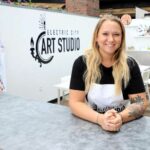As a college student, Sean Wolfe discovered there was more to beer than using it as a means to get drunk. Instead, he developed an appreciation for its flavors and became a home brewer. He founded and is president of the Scranton Brewer’s Guild and is the beer events coordinator at Cooper’s Seafood House, Scranton. Outside his hobby, Wolfe works as a safety analyst at Lockheed Martin in Archbald. He is a graduate of Abington Heights High School and Penn State University, where he studied environmental resource management. He and his wife, Christina, live in Clarks Green with their children, Isabella, 7, and Giovanni, 4.
Meet Sean Wolfe…
Tell me about your work at Lockheed Martin.
I’m in charge of all the personnel safety and pretty much tasked with protecting the employees and keeping them safe. My primary responsibilities are OSHA compliance. I also do worker’s comp and injury management. I lucked out my entire life. I’ve been able to stay in the northeast region. I started out in environmental compliance at Waste Management and got into safety when I got to Lockheed.
Tell me about your job as a beer educator.
As beer events coordinator, I run the beer club. We meet monthly and do commercial beer samplings and run events. We try to host four or five breweries that are collaborative events, then we do special events during the year like a Valentine’s Day where we pair beer and chocolate, and we do an Easter one where we pair beer with different types of Peeps and Easter candy. We try to have a lot of fun with it. The idea is that we’re trying to get people exposed to different flavors and different aspects of beer.
Tell me about your home brewing. What got you started?
I started home brewing in college, and it has grown and progressed through my involvement at Cooper’s. When I was in college, my friend’s dad brought us a case of Sam Adams and said we should drink real beer. I was really excited about it, so I proceeded to go out and buy a case of Sam Adams. On a college budget, I couldn’t do it. So, I wrote a letter to Sam Adams beer company and was really just hoping to get a T-shirt. A couple weeks later, I got a letter back from Jim Koch, the owner of Sam Adams. It basically said, “Hey, it’s a great thing you like my beer. If you like beer, I suggest you try home brewing it.” There was a gift card in there for a local home brew. That started me home brewing. Me and my roommate called ourselves “Two Fat Guys Brewing.” When I moved home, I brought the brewing with me.
How did the Scranton Brewers Guild begin?
When I returned home from college, I started hanging out with a couple people who all liked home brewing. There were enough of us that we thought we should have a reason to meet. Eight years ago, we met for the first time and founded the Scranton Brewers Guild. It started off as no more than a reason for a group of us and our wives to home brew and have couple drinks. My wife is also an accomplished brewer. She’s won more awards than me. It’s a fun thing we have together. Soon we got more ambitious and started going to beer festivals and the National Homebrew Conference. Now we’re a group of 30 to 40 people. We do two main beer festivals a year, one of the larger home brew competitions in our area, and we really push the education and support of the craft.
Tell me about the educational aspect of the brewer’s guild.
Everything from the brewing process, how to become a better brewer, different techniques you can use to make different styles of beer, different types of ingredients, better use of hops. At the end of it, home brewers are just really geeky science folks who really like chemistry. Brewing is just a lot of chemistry, how molecules work together and heat extracts starches and enzymes work. What we try and bring to the local community is an appreciation for what beer is. We try to promote the idea that beer is not just a thing to do on a Friday night. We’ve done classes on bourbon barrel-aged beers and what the bourbon brings to the beer. We’ve brewed a bunch of pale ale and add different things to the pale ale to see how it ferments. Another big thing is beer history. Prohibition is a big topic for us. Scranton played a huge role in not only Prohibition, but we have a huge beer culture here. At one point we had seven different breweries in this area. One of my favorite topics to talk about is IPAs. If you tried serving any IPAs 10 years ago, everyone would think the beer is bad and ask why it’s cloudy. We talk about how the evolution of how IPAs and flavors have changed. We feel if you appreciate what you’re drinking and what you’re putting into your body it makes it mean a little more. That just drives home why we want to home brew.
What are some aspects of homebrewing that people might not realize?
It can be something that brings families together. Right now, we make sodas and sparkling juices with our kids. We can make it taste like different things. Yes, drinking is a part of it, but we try to push the idea of knowledge too. My wife and I really try to encourage them to have an appreciation for food and what they’re eating. If you have an appreciation for food, it’s no different from going to a nice restaurant and trying something new for different flavor profiles. Drinking is the same thing. I don’t drink because there’s alcohol in beer, I drink because I appreciate the flavors. We try to impose that on our kids too. If you like something, how can you find that in something else and be creative in the kitchen. It’s cool. It can be a little mad scientisty, but it’s fun.
Can you expand on the science aspect of home brewing?
The whole thing is science. Alcohol is made by simply having yeast eat sugar. The byproduct of that is CO2 and alcohol. Whether it’s good depends on a lot of things. The science aspect of brewing is understanding how heat affects enzymes. The first part of brewing is called the mash, where you take grain and mix it with hot water and let it sit. The hot water activates the enzymes naturally inside the grain; those enzymes begin to eat the starch in the grain, which then creates sugar. How hot you do your mash will determine how much starch you can burn to sugar. It creates two kinds of sugar, fermented and non-fermented sugar. If you want a dry beer, you need to keep your temperature low so you can create a lot of fermented sugars. If you’d like a sweeter beer, you want to increase the temperature so it creates more unfermented sugar. Understanding the thermal balance is very important. The next stage is called the boil. You add heat, which locks your sugars in place, then you add hops. Knowing when to put those hops inside your boil will determine how bitter your beer is. Then you need to add yeast to make sure everything is sanitary, make sure it is a good temperature (and) get the sugar right. So there is a lot of microbiology, chemistry and thermodynamics.
What are your thoughts on how the beer industry has recently evolved in NEPA? What are you excited to see changing?
There are two paths. Some brewers are really focused on trying to make standard, really good product. Classic styles, just really, really good liquid. There are others who are making very unique styles of beer. From what I see, everyone is just looking for a good experience. When I first started drinking beer, it was in garages or basements. Now that there is so much good beer out there, people want a good experience. Some of the breweries in the area are giving fantastic experiences. You can walk in and be in an old schoolhouse, or a warehouse or a small tasting room. It offers a level of beer tourism, because a lot of these guys, you can’t get their beer at a traditional restaurant. You also have a group of people who get together and go from place to place to try it out. I like to think that craft beer today is still about being open to trying new things, working on making a really good product and pushing the boundaries of what you can do next.
What are some tips you would offer to someone looking for a good beer in Scranton?
Don’t give up. We are in a very fortunate time, especially in Scranton. We have a lot of access to some really good microbreweries in the area. When people say, “I don’t like X beer…” I encourage them to try a different beer. There are so many variants, especially when it comes to IPAs (and) stouts; maybe you just haven’t found a way you like it yet. If you like something, try another and another.
What is your favorite beer?
I hold a special place in my heart for Sam Adams. I always will, because it got me started. That would be my commercial pick. If I had to pick a noncommercial, it would be anything that comes out of my brewers guild. If I could pick a home brew, I’d pick a home brew every day, because I know it’s made with a huge amount of love and care, and I can go to the guy who made it and hear the entire story behind why it’s called what it’s called.
What other hobbies and interests do you have?
I’m a huge Penn State fan, obviously because I went there. Aside from Penn State, craft beer and my kids, my plate is pretty full.
 Can you pinpoint an “ah-ha” moment or something that was very influential in your life?
Can you pinpoint an “ah-ha” moment or something that was very influential in your life?
My parents are not craft beer people, but they are good sports. I can put any beer in front of them, and they will try it. The moment I really discovered the importance of education and getting people to try different beers was when I brought my mom a Stegmaier beer. Both she and my dad thought it was pretty good. I made a home brew, a cream ale, and I called it “Golden Louie” after my dad. My dad thought it was pretty good, and knowing that they liked that, I found craft beers that were very similar to it. I’ve proven to myself that it just takes finding the right craft beer, and you can get even the most mass-market, micro, light beer drinker to enjoy a craft beer.
Do you have anything to add?
I would consider myself very lucky to be where I’m at and work with such great people and push what I see as a very important aspect of craft beer culture. It’s not just about drinking; sometimes it’s about learning more about it.

Emma Black is a photographer and writes Up Close and Personal, which spotlights people from all walks of life in NEPA who have a unique skill, craft, talent or trade. She is a graduate of Abington Heights High School and University of Scranton, where she studied journalism and electronic media. Emma has been with Times-Shamrock Communications since 2016 and enjoys playing, coaching and following soccer; exploring international cuisine; and doing arts and crafts in her free time. Contact: eblack@timesshamrock.com; 570-348-9100; @emmablack_13




